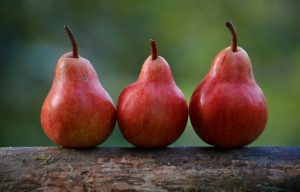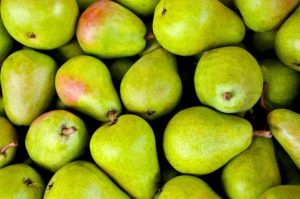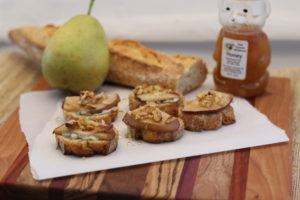 Do you know what fruit has over 3,000 varieties, helps reduce your cancer risk, and is considered “hypoallergenic?”
Do you know what fruit has over 3,000 varieties, helps reduce your cancer risk, and is considered “hypoallergenic?”
It’s the pear!
With fall, and hopefully some fall-like temperatures, just around the corner, now is the perfect time to celebrate this superfood…
which is why pears are our September Superfood of the Month!
What are pears?
 Pears are a fruit that come in a variety of colors, including green, red, yellow, gold and brown. They also come in different sizes and shapes – most varieties tend to be narrower at the stem and wider towards the base.
Pears are a fruit that come in a variety of colors, including green, red, yellow, gold and brown. They also come in different sizes and shapes – most varieties tend to be narrower at the stem and wider towards the base.
Their texture is different than an apple – while a good apple is crisp and has a good crunch, many varieties of pears are better described as “silent when eaten,” with a softer sweet texture.
Most of the world’s production of pears takes place in China. In the U.S., the largest producers are Washington (the largest producer), Oregon and California. Because pear trees can withstand cold temperatures, the fruit is harvested year-round, and they are at their best during the fall and winter.
Why pears?
 We know we sound like a broken record. As with all our Superfoods, pears are loaded with nutrition! Packed full of nutrients such as Vitamin C, Vitamin K and potassium, they are extremely nutritious, and there is more!
We know we sound like a broken record. As with all our Superfoods, pears are loaded with nutrition! Packed full of nutrients such as Vitamin C, Vitamin K and potassium, they are extremely nutritious, and there is more!
- Eat the skin — it contains half of a pear’s fiber!
- Full of phytonutrients – including tremendous antioxidant and anti-inflammatory benefits.
- Helps reduce the risk of cancer and chronic disease including heart disease and type-2 diabetes.
- Pears are filling and very easy to digest — ideal for those with stomach sensitivities.
- Considered “hypoallergenic!” It is rare that someone is allergic to pears.
- One pear has 100 calories, 5 grams of fiber and contains 12 % of the daily recommendation of Vitamin C.
What are the different varieties of pears?
 With so many varieties, colors, shapes, textures and flavors, the choices can seem overwhelming. However, there are a few varieties that are most commonly available. In grocery stores, the most common varieties are the “European pears” and “Asian pears.” Some common pears you are likely to find include:
With so many varieties, colors, shapes, textures and flavors, the choices can seem overwhelming. However, there are a few varieties that are most commonly available. In grocery stores, the most common varieties are the “European pears” and “Asian pears.” Some common pears you are likely to find include:
- Bartlett – these are typically bell-shaped and are best enjoyed when they have a yellowish-green color. You can also find Red Bartletts, which have great flavor and nutrition. They are at their best between August and January and are excellent served raw. Because they are so juicy, they tend to lose their shape and become softer when cooked. Most canned and processed pears are made from Bartletts.
- Bosc – this bronze-colored pear has a long neck and a white flesh that is sweet and crisp. You may notice a cinnamon or nutmeg flavor and it also holds its shape better when cooked, making it ideal for baking and cooking.
- Anjou – this egg-shaped pear has little or no neck and can be found in green or red. Often called the “winter pear” because it is at its best from October through May, the Anjou pear has a firmer texture, and is still sweet and juicy. With their great flavor and attractive color, Red Anjou pears work great to slice and include as part of a cheese tray.
- Asian – more like an apple than a pear because of its shape and crunch. You may also see these called “apple pears,” although it is not a cross between and apple and a pear, as some may believe. Unlike an apple, its flesh will not turn brown when exposed to air, which makes it ideal to serve raw in salads and slaws. Look for Asian pears starting in August and throughout the winter.
How do you pick the best pears?
At the store, pears are generally unripe and will require a few days to ripen to be at their best. When you purchase pears, leave them at room temperature to ripen, and then once ripe, you can store them in the refrigerator where they will remain fresh for a few days. If possible, let your pear return to room temperature to enjoy the best fragrance and flavor.
- Choose firm pears, but you don’t want them rock-hard.
- Press the neck! Press at the top of the pear near the stem to test for ripeness.
- Look for smooth skin, with no bruises.
- Speckled patches on the skin are OK…this may actually be a sign of a more robust flavor. However, avoid pears that have dark spots that have resulted from the skin being punctured.
 What about buying organic pears?
What about buying organic pears?
Since the skin of the pear is so nutritious, selecting organic pears is a good idea because pears are often sprayed with pesticides. So, take advantage of those in-season sale prices and opportunities while you can! And, it is a great idea to buy from local farmers who don’t treat their fruits with pesticides.
What can you do with pears?
We love to mix it up and include pears in a variety of meals, and we have some absolutely delicious ideas on Eat REAL America! Keep in mind, most pears will oxidize once cut so, depending on the recipe, consider tossing or brushing pears with a little lemon, lime or orange juice to prevent browning.
 Roasted Brussels Sprouts and Pears
Roasted Brussels Sprouts and Pears
Warm Pear Salad with Gorgonzola
Pear and Butternut Squash Salad
Take the Superfood challenge!
 Try pears in different ways each week during the month of September…you might be surprised and find a new way to love them!
Try pears in different ways each week during the month of September…you might be surprised and find a new way to love them!
What are your favorite ways to enjoy pears?
 LEARN MORE ABOUT THE NAPKIN!
LEARN MORE ABOUT THE NAPKIN!

Leave A Comment